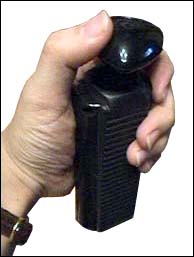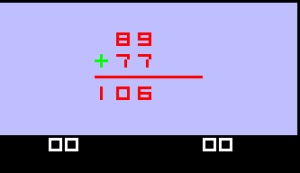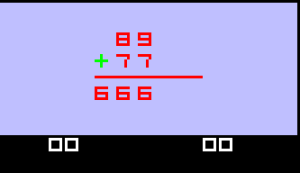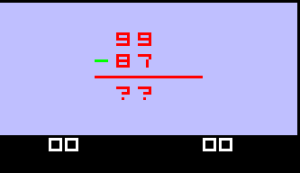Back in 1976, video games were still a very new phenomenon. The Fairchild Channel F was not the first home video game console, but it was the first one that allowed for interchangeable game cartridges. And even with the rudimentary tech inside the console, the game library shows signs of creativity beyond just Pong.
Math Quiz I (Addition & Subtraction) (1977)
Released on the last day of 1977, this game is about as basic as a quiz game can possibly get. The title says it all.
I’m using the program MESS to emulate the Channel F, and it’s a rather old version too.
I’ve found that newer versions of MESS don’t play nice with my computer or with Channel F emulation. The interface has been dumbed down too. C’est la vie.
To get the game started requires a bit of know-how about how MESS handles emulation of the peculiarities of the Channel F hardware. The screenshot above is asking which game to play, addition or subtraction.
I pressed 5 to play the addition part of the game, and now I think it’s asking me if I’m ready to start. To proceed, I press 8.
And this is it. I told you it was a math quiz. What’s 89 + 77? If you figured out that it’s 166, then gold star for you, but we’re only part of the way there. We have to enter that answer with the Channel F controller (or the emulated version).
This controller is an odd beast. It was designed mainly to play Pong-like games. The top portion can be moved around like a joystick and pressed in like a button – but it can also be pulled out to act like another button. I’m not sure exactly how MESS emulates this, but I managed to set up my trusty Logitech gamepad to play most of the Channel F games.
The thing is that the controls as mapped to my gamepad don’t intuitively match what the game expects.
So let’s start pressing some buttons. I already figured out that 2 on my gamepad submits the answer, so I won’t press that until I should. Button number 1 made the hundreds position climb. So far so good.
Oh shit. No, no, no, this isn’t the right answer. That was button 4.
Thankfully, the buttons cycle through the digits, so you can revise your answer. Pressing right on the joystick gave me control of the ones position. I was able to change the digit by pressing 1.
How did I accomplish this?
I started pressing buttons madly, but then I figured something out.
The left and right joystick toggle control of the thousands and tens position or hundreds and ones position. Button 4 toggles control of the thousands and tens position or hundreds and ones position.
Well, shit, that’s counterintuitive. I can’t see how that would even be easy to figure out with the actual controller. Button 3 on my controller moves on to the next question.
Let’s move on to Subtraction, or as I call it – “Addition’s Tricky Friend”.
The answer we’re trying to enter here is 12.
Arrrgh…
Damn it! Even when I know how to control the game it’s not easy.
Okay, I got it entered. This feels more like a test of manual dexterity than a test of mental acuity.
Math Quiz II (Multiplication & Division) (1977)
This game was released on the same day as it’s twin, on the next sequentially numbered Channel F cartridge.
Another game, the same controls apply to start it. 5 for Multiplication, 6 for Division.
And 8 to start.
After so much practice with the controls, I didn’t fuck up once during this round.
Hooray for me!
I was surprised to see the questions here in long division form.
This was the only one I didn’t need a calculator for!
So what can I say about these games? I personally won’t call them fun. I have dyscalculia, so arithmetic is never fun for me. But I grudgingly accept that there are people who like doing stuff like this – perhaps dozens.
A question that often comes up in modern reviews of old games is “is this worth playing today”. And my answer in this case is no. But I must say that these two Math Quiz games show us a lot about the quiz game genre in general. You don’t need a lot of graphical display power to have made a quiz game. These type of games are all about the content, for the most part.
I doubt I’ll ever play these again, and they’re definitely not standouts of either the Channel F library or the quiz game genre in general. But it’s interesting to see a very early example that, for the most part, works.

























